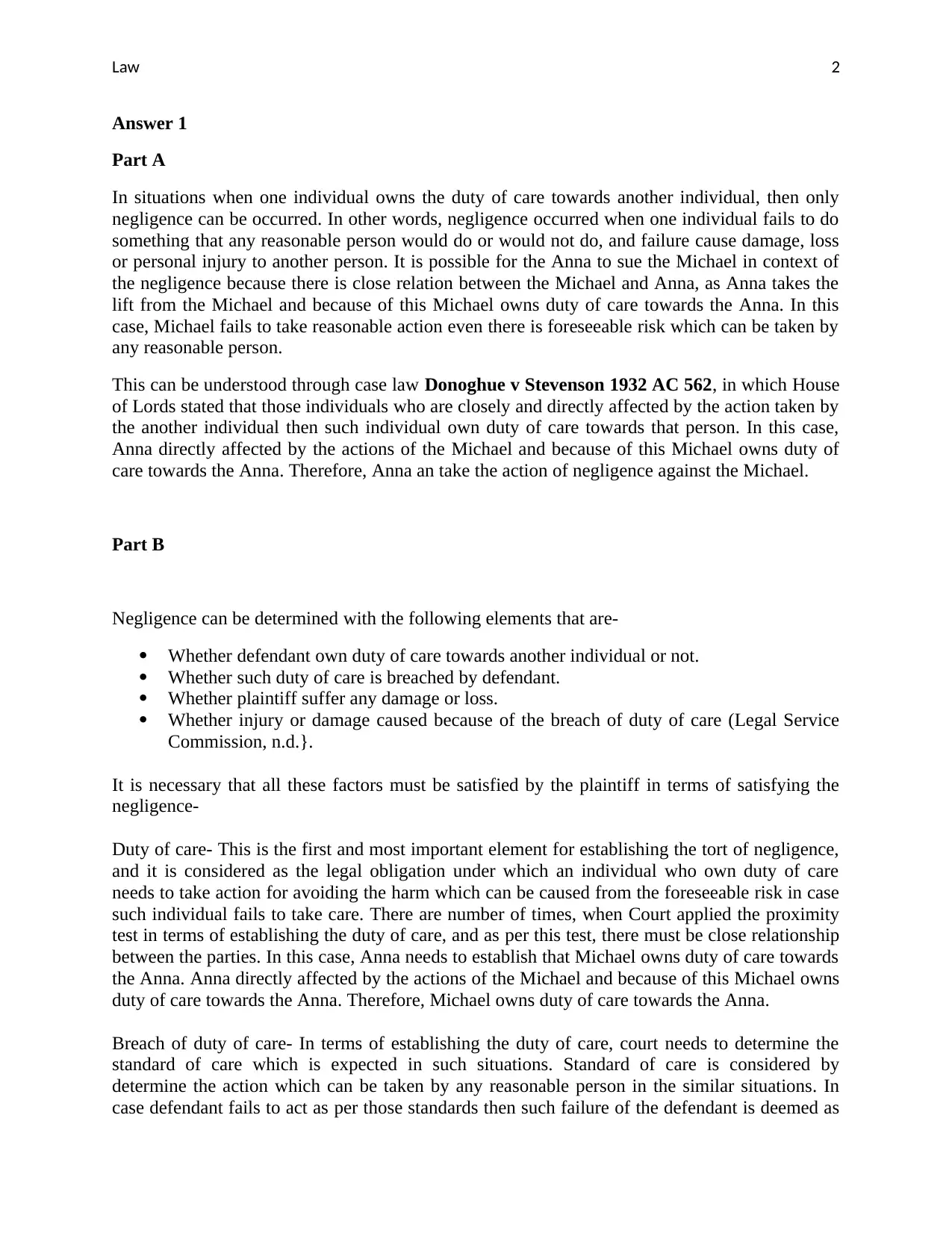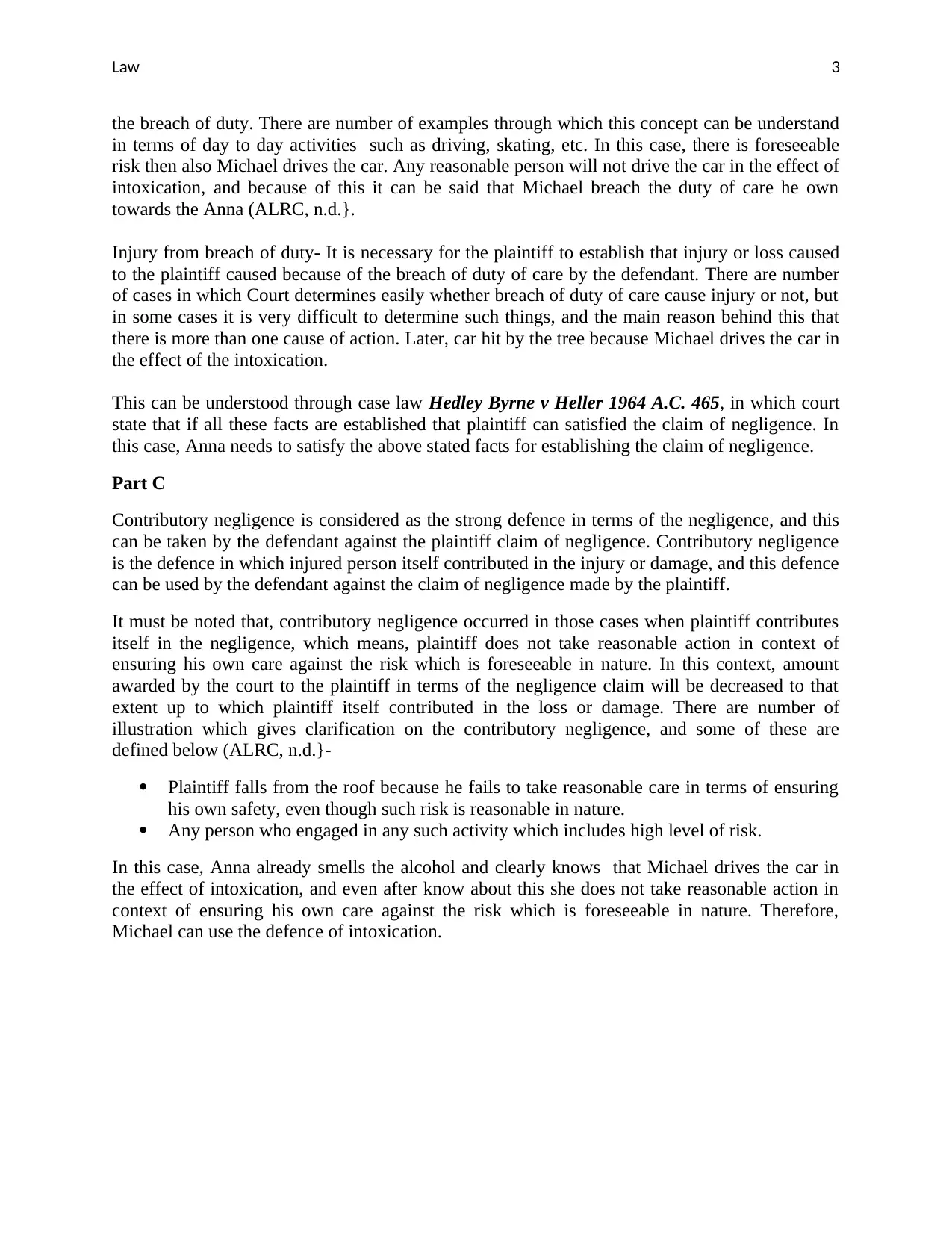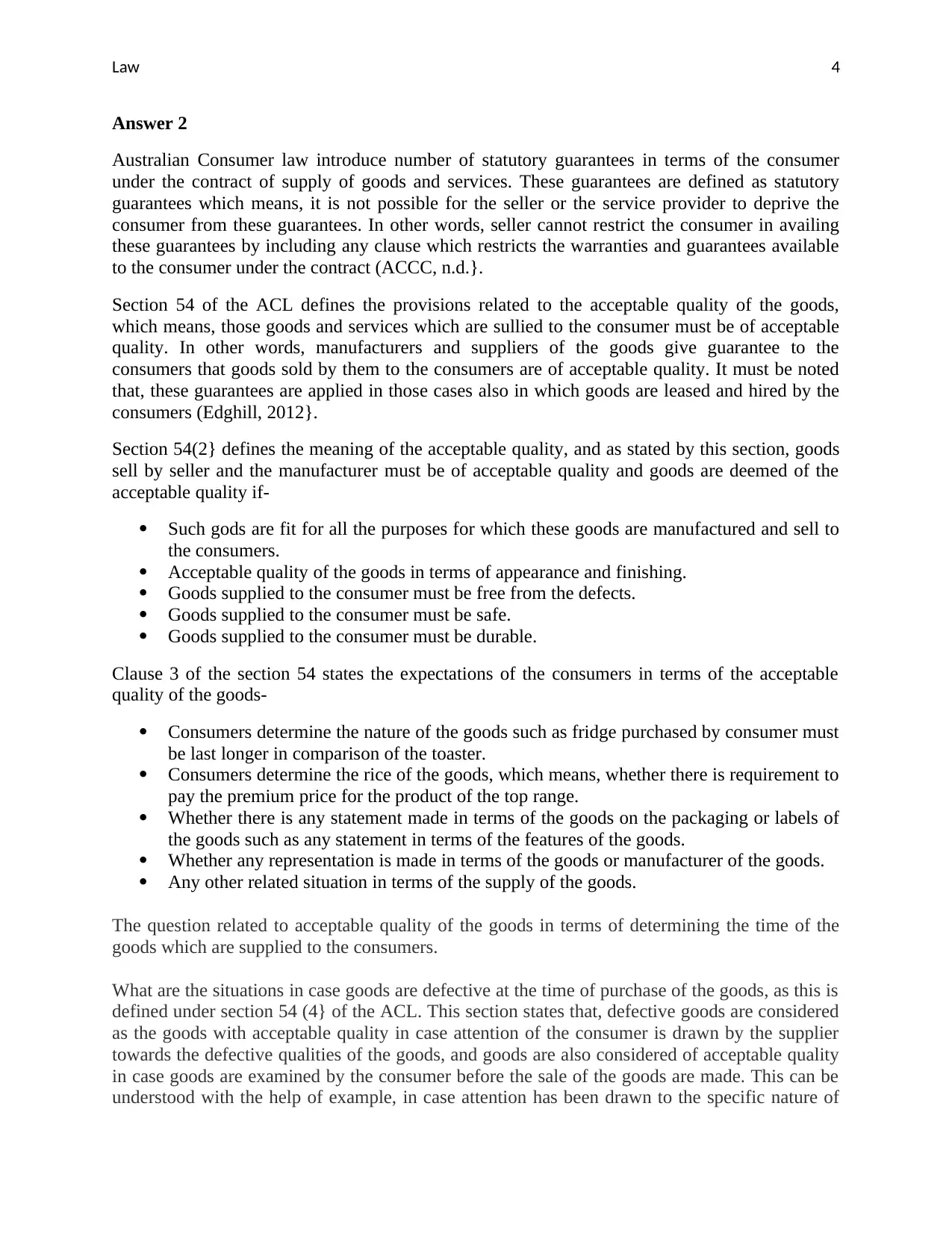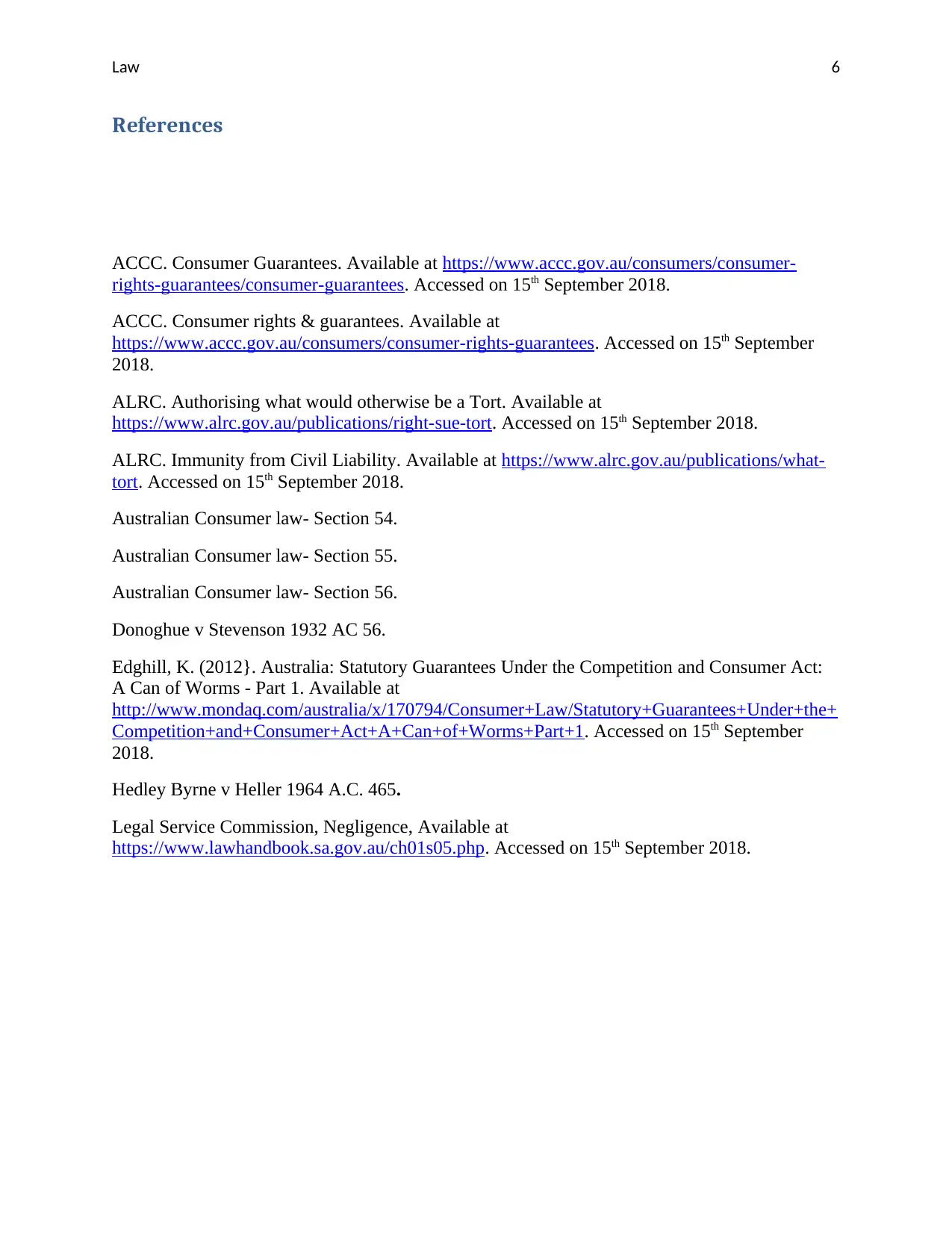Law Assignment: Negligence, Consumer Guarantees, and ACL Regulations
VerifiedAdded on 2023/06/05
|6
|2305
|498
Homework Assignment
AI Summary
This law assignment solution addresses two key areas: negligence and Australian Consumer Law (ACL). The first part analyzes a scenario involving negligence, defining duty of care, breach of duty, and contributory negligence. It references relevant case law, such as Donoghue v Stevenson and Hedley Byrne v Heller, to support the arguments. The second part focuses on consumer law, specifically the statutory guarantees provided under the ACL. It explains the concept of acceptable quality (Section 54) and fitness for disclosed purpose (Section 55), detailing the rights and protections available to consumers. The solution provides a comprehensive overview of these legal concepts, supported by relevant sections of the ACL and case law, making it a valuable resource for law students.

Law
1
Law
1
Law
Paraphrase This Document
Need a fresh take? Get an instant paraphrase of this document with our AI Paraphraser

Law 2
Answer 1
Part A
In situations when one individual owns the duty of care towards another individual, then only
negligence can be occurred. In other words, negligence occurred when one individual fails to do
something that any reasonable person would do or would not do, and failure cause damage, loss
or personal injury to another person. It is possible for the Anna to sue the Michael in context of
the negligence because there is close relation between the Michael and Anna, as Anna takes the
lift from the Michael and because of this Michael owns duty of care towards the Anna. In this
case, Michael fails to take reasonable action even there is foreseeable risk which can be taken by
any reasonable person.
This can be understood through case law Donoghue v Stevenson 1932 AC 562, in which House
of Lords stated that those individuals who are closely and directly affected by the action taken by
the another individual then such individual own duty of care towards that person. In this case,
Anna directly affected by the actions of the Michael and because of this Michael owns duty of
care towards the Anna. Therefore, Anna an take the action of negligence against the Michael.
Part B
Negligence can be determined with the following elements that are-
Whether defendant own duty of care towards another individual or not.
Whether such duty of care is breached by defendant.
Whether plaintiff suffer any damage or loss.
Whether injury or damage caused because of the breach of duty of care (Legal Service
Commission, n.d.}.
It is necessary that all these factors must be satisfied by the plaintiff in terms of satisfying the
negligence-
Duty of care- This is the first and most important element for establishing the tort of negligence,
and it is considered as the legal obligation under which an individual who own duty of care
needs to take action for avoiding the harm which can be caused from the foreseeable risk in case
such individual fails to take care. There are number of times, when Court applied the proximity
test in terms of establishing the duty of care, and as per this test, there must be close relationship
between the parties. In this case, Anna needs to establish that Michael owns duty of care towards
the Anna. Anna directly affected by the actions of the Michael and because of this Michael owns
duty of care towards the Anna. Therefore, Michael owns duty of care towards the Anna.
Breach of duty of care- In terms of establishing the duty of care, court needs to determine the
standard of care which is expected in such situations. Standard of care is considered by
determine the action which can be taken by any reasonable person in the similar situations. In
case defendant fails to act as per those standards then such failure of the defendant is deemed as
Answer 1
Part A
In situations when one individual owns the duty of care towards another individual, then only
negligence can be occurred. In other words, negligence occurred when one individual fails to do
something that any reasonable person would do or would not do, and failure cause damage, loss
or personal injury to another person. It is possible for the Anna to sue the Michael in context of
the negligence because there is close relation between the Michael and Anna, as Anna takes the
lift from the Michael and because of this Michael owns duty of care towards the Anna. In this
case, Michael fails to take reasonable action even there is foreseeable risk which can be taken by
any reasonable person.
This can be understood through case law Donoghue v Stevenson 1932 AC 562, in which House
of Lords stated that those individuals who are closely and directly affected by the action taken by
the another individual then such individual own duty of care towards that person. In this case,
Anna directly affected by the actions of the Michael and because of this Michael owns duty of
care towards the Anna. Therefore, Anna an take the action of negligence against the Michael.
Part B
Negligence can be determined with the following elements that are-
Whether defendant own duty of care towards another individual or not.
Whether such duty of care is breached by defendant.
Whether plaintiff suffer any damage or loss.
Whether injury or damage caused because of the breach of duty of care (Legal Service
Commission, n.d.}.
It is necessary that all these factors must be satisfied by the plaintiff in terms of satisfying the
negligence-
Duty of care- This is the first and most important element for establishing the tort of negligence,
and it is considered as the legal obligation under which an individual who own duty of care
needs to take action for avoiding the harm which can be caused from the foreseeable risk in case
such individual fails to take care. There are number of times, when Court applied the proximity
test in terms of establishing the duty of care, and as per this test, there must be close relationship
between the parties. In this case, Anna needs to establish that Michael owns duty of care towards
the Anna. Anna directly affected by the actions of the Michael and because of this Michael owns
duty of care towards the Anna. Therefore, Michael owns duty of care towards the Anna.
Breach of duty of care- In terms of establishing the duty of care, court needs to determine the
standard of care which is expected in such situations. Standard of care is considered by
determine the action which can be taken by any reasonable person in the similar situations. In
case defendant fails to act as per those standards then such failure of the defendant is deemed as

Law 3
the breach of duty. There are number of examples through which this concept can be understand
in terms of day to day activities such as driving, skating, etc. In this case, there is foreseeable
risk then also Michael drives the car. Any reasonable person will not drive the car in the effect of
intoxication, and because of this it can be said that Michael breach the duty of care he own
towards the Anna (ALRC, n.d.}.
Injury from breach of duty- It is necessary for the plaintiff to establish that injury or loss caused
to the plaintiff caused because of the breach of duty of care by the defendant. There are number
of cases in which Court determines easily whether breach of duty of care cause injury or not, but
in some cases it is very difficult to determine such things, and the main reason behind this that
there is more than one cause of action. Later, car hit by the tree because Michael drives the car in
the effect of the intoxication.
This can be understood through case law Hedley Byrne v Heller 1964 A.C. 465, in which court
state that if all these facts are established that plaintiff can satisfied the claim of negligence. In
this case, Anna needs to satisfy the above stated facts for establishing the claim of negligence.
Part C
Contributory negligence is considered as the strong defence in terms of the negligence, and this
can be taken by the defendant against the plaintiff claim of negligence. Contributory negligence
is the defence in which injured person itself contributed in the injury or damage, and this defence
can be used by the defendant against the claim of negligence made by the plaintiff.
It must be noted that, contributory negligence occurred in those cases when plaintiff contributes
itself in the negligence, which means, plaintiff does not take reasonable action in context of
ensuring his own care against the risk which is foreseeable in nature. In this context, amount
awarded by the court to the plaintiff in terms of the negligence claim will be decreased to that
extent up to which plaintiff itself contributed in the loss or damage. There are number of
illustration which gives clarification on the contributory negligence, and some of these are
defined below (ALRC, n.d.}-
Plaintiff falls from the roof because he fails to take reasonable care in terms of ensuring
his own safety, even though such risk is reasonable in nature.
Any person who engaged in any such activity which includes high level of risk.
In this case, Anna already smells the alcohol and clearly knows that Michael drives the car in
the effect of intoxication, and even after know about this she does not take reasonable action in
context of ensuring his own care against the risk which is foreseeable in nature. Therefore,
Michael can use the defence of intoxication.
the breach of duty. There are number of examples through which this concept can be understand
in terms of day to day activities such as driving, skating, etc. In this case, there is foreseeable
risk then also Michael drives the car. Any reasonable person will not drive the car in the effect of
intoxication, and because of this it can be said that Michael breach the duty of care he own
towards the Anna (ALRC, n.d.}.
Injury from breach of duty- It is necessary for the plaintiff to establish that injury or loss caused
to the plaintiff caused because of the breach of duty of care by the defendant. There are number
of cases in which Court determines easily whether breach of duty of care cause injury or not, but
in some cases it is very difficult to determine such things, and the main reason behind this that
there is more than one cause of action. Later, car hit by the tree because Michael drives the car in
the effect of the intoxication.
This can be understood through case law Hedley Byrne v Heller 1964 A.C. 465, in which court
state that if all these facts are established that plaintiff can satisfied the claim of negligence. In
this case, Anna needs to satisfy the above stated facts for establishing the claim of negligence.
Part C
Contributory negligence is considered as the strong defence in terms of the negligence, and this
can be taken by the defendant against the plaintiff claim of negligence. Contributory negligence
is the defence in which injured person itself contributed in the injury or damage, and this defence
can be used by the defendant against the claim of negligence made by the plaintiff.
It must be noted that, contributory negligence occurred in those cases when plaintiff contributes
itself in the negligence, which means, plaintiff does not take reasonable action in context of
ensuring his own care against the risk which is foreseeable in nature. In this context, amount
awarded by the court to the plaintiff in terms of the negligence claim will be decreased to that
extent up to which plaintiff itself contributed in the loss or damage. There are number of
illustration which gives clarification on the contributory negligence, and some of these are
defined below (ALRC, n.d.}-
Plaintiff falls from the roof because he fails to take reasonable care in terms of ensuring
his own safety, even though such risk is reasonable in nature.
Any person who engaged in any such activity which includes high level of risk.
In this case, Anna already smells the alcohol and clearly knows that Michael drives the car in
the effect of intoxication, and even after know about this she does not take reasonable action in
context of ensuring his own care against the risk which is foreseeable in nature. Therefore,
Michael can use the defence of intoxication.
⊘ This is a preview!⊘
Do you want full access?
Subscribe today to unlock all pages.

Trusted by 1+ million students worldwide

Law 4
Answer 2
Australian Consumer law introduce number of statutory guarantees in terms of the consumer
under the contract of supply of goods and services. These guarantees are defined as statutory
guarantees which means, it is not possible for the seller or the service provider to deprive the
consumer from these guarantees. In other words, seller cannot restrict the consumer in availing
these guarantees by including any clause which restricts the warranties and guarantees available
to the consumer under the contract (ACCC, n.d.}.
Section 54 of the ACL defines the provisions related to the acceptable quality of the goods,
which means, those goods and services which are sullied to the consumer must be of acceptable
quality. In other words, manufacturers and suppliers of the goods give guarantee to the
consumers that goods sold by them to the consumers are of acceptable quality. It must be noted
that, these guarantees are applied in those cases also in which goods are leased and hired by the
consumers (Edghill, 2012}.
Section 54(2} defines the meaning of the acceptable quality, and as stated by this section, goods
sell by seller and the manufacturer must be of acceptable quality and goods are deemed of the
acceptable quality if-
Such gods are fit for all the purposes for which these goods are manufactured and sell to
the consumers.
Acceptable quality of the goods in terms of appearance and finishing.
Goods supplied to the consumer must be free from the defects.
Goods supplied to the consumer must be safe.
Goods supplied to the consumer must be durable.
Clause 3 of the section 54 states the expectations of the consumers in terms of the acceptable
quality of the goods-
Consumers determine the nature of the goods such as fridge purchased by consumer must
be last longer in comparison of the toaster.
Consumers determine the rice of the goods, which means, whether there is requirement to
pay the premium price for the product of the top range.
Whether there is any statement made in terms of the goods on the packaging or labels of
the goods such as any statement in terms of the features of the goods.
Whether any representation is made in terms of the goods or manufacturer of the goods.
Any other related situation in terms of the supply of the goods.
The question related to acceptable quality of the goods in terms of determining the time of the
goods which are supplied to the consumers.
What are the situations in case goods are defective at the time of purchase of the goods, as this is
defined under section 54 (4} of the ACL. This section states that, defective goods are considered
as the goods with acceptable quality in case attention of the consumer is drawn by the supplier
towards the defective qualities of the goods, and goods are also considered of acceptable quality
in case goods are examined by the consumer before the sale of the goods are made. This can be
understood with the help of example, in case attention has been drawn to the specific nature of
Answer 2
Australian Consumer law introduce number of statutory guarantees in terms of the consumer
under the contract of supply of goods and services. These guarantees are defined as statutory
guarantees which means, it is not possible for the seller or the service provider to deprive the
consumer from these guarantees. In other words, seller cannot restrict the consumer in availing
these guarantees by including any clause which restricts the warranties and guarantees available
to the consumer under the contract (ACCC, n.d.}.
Section 54 of the ACL defines the provisions related to the acceptable quality of the goods,
which means, those goods and services which are sullied to the consumer must be of acceptable
quality. In other words, manufacturers and suppliers of the goods give guarantee to the
consumers that goods sold by them to the consumers are of acceptable quality. It must be noted
that, these guarantees are applied in those cases also in which goods are leased and hired by the
consumers (Edghill, 2012}.
Section 54(2} defines the meaning of the acceptable quality, and as stated by this section, goods
sell by seller and the manufacturer must be of acceptable quality and goods are deemed of the
acceptable quality if-
Such gods are fit for all the purposes for which these goods are manufactured and sell to
the consumers.
Acceptable quality of the goods in terms of appearance and finishing.
Goods supplied to the consumer must be free from the defects.
Goods supplied to the consumer must be safe.
Goods supplied to the consumer must be durable.
Clause 3 of the section 54 states the expectations of the consumers in terms of the acceptable
quality of the goods-
Consumers determine the nature of the goods such as fridge purchased by consumer must
be last longer in comparison of the toaster.
Consumers determine the rice of the goods, which means, whether there is requirement to
pay the premium price for the product of the top range.
Whether there is any statement made in terms of the goods on the packaging or labels of
the goods such as any statement in terms of the features of the goods.
Whether any representation is made in terms of the goods or manufacturer of the goods.
Any other related situation in terms of the supply of the goods.
The question related to acceptable quality of the goods in terms of determining the time of the
goods which are supplied to the consumers.
What are the situations in case goods are defective at the time of purchase of the goods, as this is
defined under section 54 (4} of the ACL. This section states that, defective goods are considered
as the goods with acceptable quality in case attention of the consumer is drawn by the supplier
towards the defective qualities of the goods, and goods are also considered of acceptable quality
in case goods are examined by the consumer before the sale of the goods are made. This can be
understood with the help of example, in case attention has been drawn to the specific nature of
Paraphrase This Document
Need a fresh take? Get an instant paraphrase of this document with our AI Paraphraser

Law 5
the defect occurred in the goods such as hole in the t-shirts, then such gods will be considered as
the goods of the acceptable quality. However, in case attention of the consumer is drawn
towards the specific defect, and later another defect occurred and another defect does not related
to the first defect then goods may not considered as of acceptable quality.
There is an exception also, which states that guarantee will not apply in those cases in which
consumers conduct any such action because of which goods become of unacceptable quality, or
fail to take any reasonable action which restrict the goods in becoming the goods of unacceptable
quality, or in case goods are damaged by because of the abnormal use of the goods.
Section 55 of the ACL defines provisions related to the fitness of the goods in terms of the
disclosed purpose, which means, those goods and services which are sullied to the consumer
must be fit for the disclosed purpose. In other words, manufacturers and suppliers of the goods
give guarantee to the consumers that goods sold by them to the consumers are fit with any
purpose which is stated by the manufacturer (ACCC, n.d.}.
There is an exception also, which states that this guarantee will not implement in those situations
in which it is clear that consumer does not rely on the disclosed aim, or it is completely
unreasonable for the consumer to rely on the skill or judgment of the seller.
In this case, ovens provided by the Restaurant Equipment are not reliable which means they are
not of acceptable quality, and in terms of the ovens Owen Ronald does not get any warranty.
Australian Consumer law introduce number of statutory guarantees in terms of the consumer
under the contract of supply of goods and services. These guarantees are defined as statutory
guarantees which means, it is not possible for the seller or the service provider to deprive the
consumer from these guarantees. Therefore, these statutory guarantees are also available to the
Owen Ronaldo. Guarantee under section 54 and 55 will implement in this case.
Section 54 of the ACL defines the provisions related to the acceptable quality of the goods,
which means, manufacturers and suppliers of the goods give guarantee to the consumers that
goods sold by them to the consumers are of acceptable quality. It must be noted that, these
guarantees are applied in those cases also in which goods are leased and hired by the consumers.
On the other hand, Section 55 of the ACL defines provisions related to the fitness of the goods in
terms of the disclosed purpose, which means, those goods and services which are sullied to the
consumer must be fit for the disclosed purpose.
Therefore, Owen Ronaldo can replace the ovens because these ovens are not of acceptable
quality.
the defect occurred in the goods such as hole in the t-shirts, then such gods will be considered as
the goods of the acceptable quality. However, in case attention of the consumer is drawn
towards the specific defect, and later another defect occurred and another defect does not related
to the first defect then goods may not considered as of acceptable quality.
There is an exception also, which states that guarantee will not apply in those cases in which
consumers conduct any such action because of which goods become of unacceptable quality, or
fail to take any reasonable action which restrict the goods in becoming the goods of unacceptable
quality, or in case goods are damaged by because of the abnormal use of the goods.
Section 55 of the ACL defines provisions related to the fitness of the goods in terms of the
disclosed purpose, which means, those goods and services which are sullied to the consumer
must be fit for the disclosed purpose. In other words, manufacturers and suppliers of the goods
give guarantee to the consumers that goods sold by them to the consumers are fit with any
purpose which is stated by the manufacturer (ACCC, n.d.}.
There is an exception also, which states that this guarantee will not implement in those situations
in which it is clear that consumer does not rely on the disclosed aim, or it is completely
unreasonable for the consumer to rely on the skill or judgment of the seller.
In this case, ovens provided by the Restaurant Equipment are not reliable which means they are
not of acceptable quality, and in terms of the ovens Owen Ronald does not get any warranty.
Australian Consumer law introduce number of statutory guarantees in terms of the consumer
under the contract of supply of goods and services. These guarantees are defined as statutory
guarantees which means, it is not possible for the seller or the service provider to deprive the
consumer from these guarantees. Therefore, these statutory guarantees are also available to the
Owen Ronaldo. Guarantee under section 54 and 55 will implement in this case.
Section 54 of the ACL defines the provisions related to the acceptable quality of the goods,
which means, manufacturers and suppliers of the goods give guarantee to the consumers that
goods sold by them to the consumers are of acceptable quality. It must be noted that, these
guarantees are applied in those cases also in which goods are leased and hired by the consumers.
On the other hand, Section 55 of the ACL defines provisions related to the fitness of the goods in
terms of the disclosed purpose, which means, those goods and services which are sullied to the
consumer must be fit for the disclosed purpose.
Therefore, Owen Ronaldo can replace the ovens because these ovens are not of acceptable
quality.

Law 6
References
ACCC. Consumer Guarantees. Available at https://www.accc.gov.au/consumers/consumer-
rights-guarantees/consumer-guarantees. Accessed on 15th September 2018.
ACCC. Consumer rights & guarantees. Available at
https://www.accc.gov.au/consumers/consumer-rights-guarantees. Accessed on 15th September
2018.
ALRC. Authorising what would otherwise be a Tort. Available at
https://www.alrc.gov.au/publications/right-sue-tort. Accessed on 15th September 2018.
ALRC. Immunity from Civil Liability. Available at https://www.alrc.gov.au/publications/what-
tort. Accessed on 15th September 2018.
Australian Consumer law- Section 54.
Australian Consumer law- Section 55.
Australian Consumer law- Section 56.
Donoghue v Stevenson 1932 AC 56.
Edghill, K. (2012}. Australia: Statutory Guarantees Under the Competition and Consumer Act:
A Can of Worms - Part 1. Available at
http://www.mondaq.com/australia/x/170794/Consumer+Law/Statutory+Guarantees+Under+the+
Competition+and+Consumer+Act+A+Can+of+Worms+Part+1. Accessed on 15th September
2018.
Hedley Byrne v Heller 1964 A.C. 465.
Legal Service Commission, Negligence, Available at
https://www.lawhandbook.sa.gov.au/ch01s05.php. Accessed on 15th September 2018.
References
ACCC. Consumer Guarantees. Available at https://www.accc.gov.au/consumers/consumer-
rights-guarantees/consumer-guarantees. Accessed on 15th September 2018.
ACCC. Consumer rights & guarantees. Available at
https://www.accc.gov.au/consumers/consumer-rights-guarantees. Accessed on 15th September
2018.
ALRC. Authorising what would otherwise be a Tort. Available at
https://www.alrc.gov.au/publications/right-sue-tort. Accessed on 15th September 2018.
ALRC. Immunity from Civil Liability. Available at https://www.alrc.gov.au/publications/what-
tort. Accessed on 15th September 2018.
Australian Consumer law- Section 54.
Australian Consumer law- Section 55.
Australian Consumer law- Section 56.
Donoghue v Stevenson 1932 AC 56.
Edghill, K. (2012}. Australia: Statutory Guarantees Under the Competition and Consumer Act:
A Can of Worms - Part 1. Available at
http://www.mondaq.com/australia/x/170794/Consumer+Law/Statutory+Guarantees+Under+the+
Competition+and+Consumer+Act+A+Can+of+Worms+Part+1. Accessed on 15th September
2018.
Hedley Byrne v Heller 1964 A.C. 465.
Legal Service Commission, Negligence, Available at
https://www.lawhandbook.sa.gov.au/ch01s05.php. Accessed on 15th September 2018.
⊘ This is a preview!⊘
Do you want full access?
Subscribe today to unlock all pages.

Trusted by 1+ million students worldwide
1 out of 6
Related Documents
Your All-in-One AI-Powered Toolkit for Academic Success.
+13062052269
info@desklib.com
Available 24*7 on WhatsApp / Email
![[object Object]](/_next/static/media/star-bottom.7253800d.svg)
Unlock your academic potential
Copyright © 2020–2025 A2Z Services. All Rights Reserved. Developed and managed by ZUCOL.





